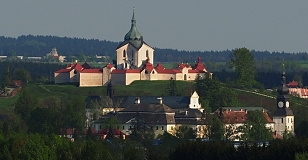Pilgrimage church equipment
It was necessary to equip the church to allow the dedication which took place in 1722. The event had to manage without permanent decorations and the church was only equipped with permanent fittings gradually. The alter as the central and most important part of the equipment was designed by architect Santini himself. The background of the alter is formed by richly decorated and pleated baldachin on a pelmet. The central sculpture is that of St. John of Nepomuk standing on a globe and rising up optically. Five eight-point Cistercian stars on the globe represent 5 continents on which Christianity has been spread. The globe is surrounded with three angels located so as to form a V-shape; other two angels, equally high and placed on the sides, are drawing aside the baldachin which forms the background of the whole scene. There are three little angels above the head of the saint; one of them is holding a key in his hand and another one is holding seal, which we can once again understand as a reference to the silence of the saint. The side alters are dedicated to the Four Evangelists: Matthew with a book, Mark with a lion, Luke with a bull and John with an eagle.
Jan Pavel Czechpauer, a sculptor from Chrudim, started to work on the main alter as well as on the side alters which were again based on Santini´s designs. After he died, the main alter was completed by sculptor Řehoř Theny only in 1729; he also made sculpture decorations for the original pulpit. The silver pilgrimage sculpture of St. John of Nepomuk was made according to the Theny´s model by Prague goldsmith Jan Norbert Diesbach.
The ground plan of the ambulatory around the church has the form of a ten-point star and has five gates. The roofs of the gates were originally decorated with five statues of John´s virtues. Three of them have been preserved to this day; the sculptures used to be accompanied by coat-of-arms bearers. Contemporary source-books also mention bells: five of them are alleged to have been there. Only negligible part of once rich stucco decorations and ribs on the vaults has been only preserved. There are five chapels in the ambulatory, out of which one is decorated with fresco paintings. This chapel used to be called a German Chapel because masses were said there in German. The architect had designed the ambulatory together with the church but it was only finished after 1735. This means that the architect did not live to see his work complete because Santini died in 1723. The purpose of the ambulatory which is frequently part of pilgrimage destinations, fulfilled practical purposes. It was used by pilgrims who came to Zelená hora; the ambulatory provided them with a shelter in the rain and they even had rest in it and slept there. The courtyard walls were decorated, especially during festive events, with a number of legendary and symbolical scenes placed in cartouches. Tough winters resulted in minor adjustments of the ambulatory in the 1760s. Some of the portals from the hall to the courtyard were walled up and gate and chapel portals were lowered.
The cemetery had never been included in the original designs of the architect; the courtyard had been covered with grass until the 19th century so that nothing would disturb the perception of the central sanctuary and there would be enough space for pilgrims coming to the church. The terrain has increased owing to burials and the ambulatory has been "drowned", which damaged the fundamental purpose of the construction. No burials take place at Zelená hora today and the tombs are gradually relocated to a near-by new cemetery. The terrain shall be lowered to the original height and the area between the church and the ambulatory shall only be covered with grass like in the past.

 Back to top
Back to top Search
Search